Saturday, January 7
Welcome to Ecuador!
Evening arrival at Quito's airport. You will be met and transferred to the hotel. Your room will be ready for immediate check-in.

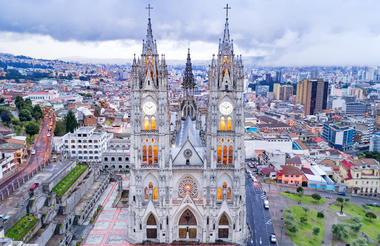
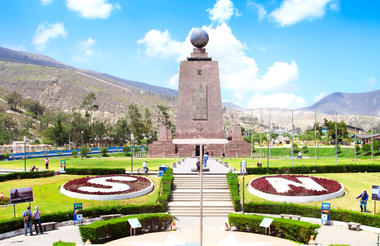
Arrival Transfer
Luxury Room
Sunday, January 8
Morning guided walking city tour of Quito.
You will start by visiting the colonial center (Independence Square, Archbishop's Palace, Government Palace, and the Cathedral). Then, you will visit the Compania de Jesus Church, San Francisco Square, and La Ronda Street.
A welcome lunch at a local restaurant after a half day exploring Quito. This will be a late lunch and will extend into mid afternoon. There will be an opportunity to explore the markets or the city before retiring for the evening.
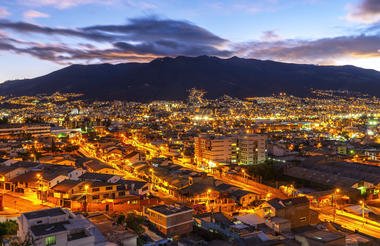


Breakfast & Lunch
Luxury Room
Guided walking tour of Old Quito
Monday, January 9
This morning you will transfer to the Cloud Forest.
Located on a scenic plateau, the Mashpi lodge features breathtaking views of the surrounding forested mountains and their unique ecosystems. The design and style enables total immersion through its floor-to-ceiling panoramic glass windows. Like a cathedral to the natural world, Mashpi is a perfect blend of luxurious comfort and personal engagement with one of the world’s most stunning environments.
Tuesday, January 10 & Wednesday, January 11
Between hiking to a waterfall, viewing the flora & fauna from the Observation tower, or perhaps enjoy life in the Hummingbird garden, the next two days will be immersed in the cloud forest.
The culinary delights of the magnificent lodge more than match the spectacular natural setting. Prepare to be indulged in a foodies heaven with.....
Breakfast: our guests enjoy a wide variety of fresh fruits from the region, different types of bread, cheeses, hams, your style of eggs, cereals, home-made jams, organic honey and granola, plus energizing fruit juices to fuel yourself up for the day’s activities.
Lunch: Deliberately light, mixing a wide variety of fresh vegetables, soups, sandwiches and a fusion of Ecuadorian and international dishes. Ceviche, an Ecuadorian classic, may be also be featured. Pair your meal with a refreshing fruit juice and then indulge in a delicious dessert.
Dinner: Is a more formal affair. The theatrical setting of the two-story dining room, which is accentuated by subdued floor lamps, creates an intimate and romantic space that is perfect for savouring our chefs’ exciting and innovative cuisine. Prepare for a culinary journey across Ecuador’s diverse regions, all of it prepared with imagination and flair.



Breakfast, Lunch, Dinner
Wayra Room
All Activities
Spa & Boutique
Thursday, January 12
Leaving the hummingbirds behind, you will travel to the Ecuadorian highlands. Time for some shopping and learning about local life in Otavalo. This is the area for leather and local artisan goods.



Breakfast & Dinner
Friday, January 13
A travel day back to Quito, arriving at airport hotel early evening. The overnight at the airport hotel makes for an easier check-in for an early flight to the Galapagos the next morning.


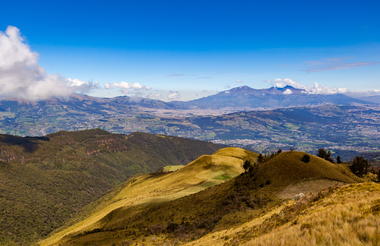
Breakfast & Lunch
Saturday, January 14
Upon arrival, transfer from Baltra Airport to the M/C Ocean Spray yacht for lunch. The Captain & crew are ready to show you around your home for the next 7 nights.
You'll head out on the waters towards your first location this afternoon.
PM: Chinese Hat
This site offers rare, up close viewing of Galapagos wildlife and well-preserved remnants of fragile volcanic rock that can't be found in such a unique condition anywhere else. The island is named after the similarity to an Asian type of hat. Here you can see American Oystercatchers and Galapagos Penguins swimming along the shores.
Activities: Hiking, snorkeling
Difficulty: Moderate
Possible Wildlife: Sea lions, various shorebirds, white-cheeked pintail ducks, penguins, Galapagos Hawks, various tropical fish, sally lightfoot crabs.



Sunday, January 15
AM: Isabela - Vicente Roca Point
Vicente Roca Point has outstanding geological formations and is a great place to see various bird species. Because this visitor site is located on the western area of the island, the Cromwell Current provides cold water that carries many nutrients for both land and aquatic species, offering the chance to see amazing feeding frenzies.
Activities: Panga ride, snorkeling
Difficulty: Easy / Moderate
Possible Wildlife: Sea lions, various shorebirds, blue-footed boobies, nazca boobies, fur seals, whales, sea turtles, various tropical fish, sally lightfoot crabs and other marine species.
PM: Fernandina - Espinosa Point
As one of the most pristine islands in the archipelago, Fernandina has never had a foreign species invade. It is also the most active island and farthest west. Espinosa point is the only visitor site on the entire island. Here you can see marine iguanas, Galapagos hawks and enjoy a hike and/or snorkeling activity at one of the most natural, unspoiled sites in the entire world.
Activities: Hiking, snorkeling
Difficulty: Easy/Moderate
Possible Wildlife: Flightless cormorant, marine iguanas, land iguanas, penguins, sea lions, various shorebirds, Galapagos Hawks, various tropical fish, sally lightfoot crabs, sea turtles.
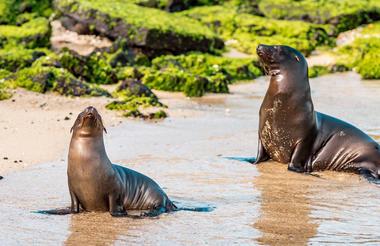
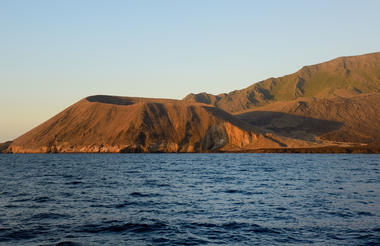
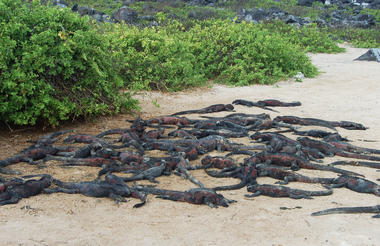
Monday, January 16
AM: Isabela - Tagus Cove
If you like historic remnants, then you will enjoy finding what was left behind by pirates and sailors in the 1800s. This site was one of their preferred pit stops while traveling the seas. The hike here will provide incredible views of the cove and on the other side the mangrove forest where the last 35 pairs of Mangrove finches thrive.
Activities: Hike, snorkeling and panga ride
Difficulty: Moderate to Difficult
Possible Wildlife: Sea lions, various shorebirds, flightless cormorant, Galapagos penguins, marine iguanas, sally lightfoot crabs, mangrove finches.
PM: Isabela - Urbina Bay
Millions of years ago, Urbina Bay was once laying on the ocean floor. Volcanic uplifts caused it to rise and now it is occupied by sea lions, land iguanas and flightless cormorants.
Activities: Hike, snorkeling and panga ride
Difficulty: Moderate to Difficult
Possible Wildlife: Sea lions, various shorebirds, flightless cormorant, marine iguanas, sea turtles, land iguanas, Galapagos Hawk, sally lightfoot crabs, Galapagos tortoise.
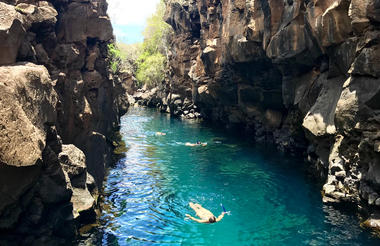
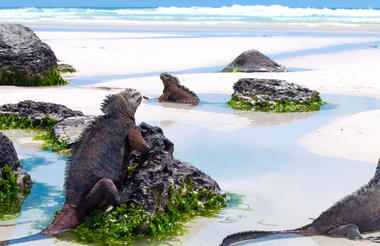
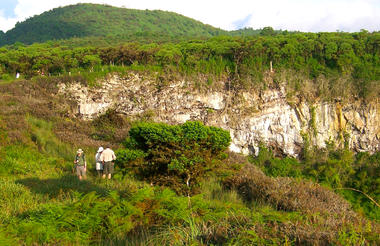
Tuesday, January 17
AM: Isabela - Elizabeth Bay
This area is great for snorkeling and getting out on the zodiac boats to explore.
Activities: zodiac explorations
Difficulty: Easy
Possible Wildlife: Sea lions, frigate birds, sea turtles, various shorebirds, flightless cormorant, marine iguanas, pelicans, sally lightfoot crabs, tropical fish and marine life such as Galapagos sharks.
PM: Isabela - Moreno Point
The beautiful rocky shores of Moreno Point offers a plethora of birds to be seen. It is truly a birders delight. The main attraction are the coast lagoons where white tipped sharks can be seen and the panoramic views of Sierra Negra and Cerro Azul volcanoes cannot be missed.
Activities: Hike, snorkeling and zodiac explorations
Difficulty: Moderate
Possible Wildlife: Sea lions, great blue herons, various shorebirds, flightless cormorant, marine iguanas, sally lightfoot crabs, sea turtles, land iguanas, Galápagos Hawk, Galapagos tortoise.



Wednesday, January 18
AM: Santa Cruz - Charles Darwin Research Station
The Charles Darwin Research Station is one of the Galapagos Island’s most important sites for visitors. It is a research facility that has an extensive collection of Galapagos plant life specimens carefully preserved and also acts as a biological research station and active breeding center operated by the Charles Darwin Foundation. Their biggest conservation efforts are to one day eliminate all invasive and non-native plants and animals destroying endemic species within the islands.
Activities: Visit to the research station
Difficulty: Moderate to Difficult
Possible Wildlife: Galapagos tortoises
PM: Santa Cruz - Highlands
The highlands are located in the northern part of Santa Cruz and can reach elevations up to 1500 meters. This area is rich with hills, ferns, volcanoes and wildlife. A great contrast to the molten lava hardened beaches and rocky areas of other islands already seen. It is home to giant tortoises, mockingbirds, finches and many other species.
Activities: Hike
Difficulty: Moderate
Possible Wildlife: Galapagos tortoises, finches, mockingbirds, lava lizards, pintail ducks, other shorebirds.



Thursday, January 19
AM: South Plaza Island
South Plaza is one of the smallest islands with a visitor site, but is home to an incredible amount of diverse flora and fauna. It has a large population of Sesuvium plants like the prickly pear cactus tree that is an important source of food for the land iguana. Just a few years ago mice were finally eradicated from the island, helping the population of land iguanas grow healthily once more. The amazing colors of the turquoise waters against the black lava create a setting for amazing photography opportunities.
Activities: Hike
Difficulty: Moderate
Possible Wildlife: frigatebirds, sally lightfoot crabs, sea lions, land iguanas, swallow-tailed gulls, various shorebirds and seabirds.
PM: Santa Fe Island
Santa Fe is home to the endemic Santa Fe iguana. The island was created by a volcanic uplift that now hosts a forest of Opuntia and Palo Santo trees. It is a picturesque island with two different trails, one leading to a scenic viewpoint and the other leading to a small beach.
Activities: Hike
Difficulty: Moderate
Possible Wildlife: Santa Fe land iguanas, frigatebirds, sally lightfoot crabs, sea lions, finches, various shorebirds.



Friday, January 20
AM: Española - Suarez Point
This is a phenomenal site where you will get to see many of Española Island's endemic species. The trail will pass by the only Waved Albatross breeding site in all of Galapagos. If you are lucky you might see a young albatross take off for its first flight for up to five years at sea. Older birds stay at sea for months at a time, only coming back to breed. Other species that can be seen are marine iguanas, that stay brightly colored year round, Galapagos doves, Nazca boobies, blue-footed boobies, swallow-tailed gulls, red-billed tropic birds, and Darwin finches.
Activities: Hike
Difficulty: Easy/Moderate
Possible Wildlife: Sea lions, marine iguanas, Galapagos hawk, waved albatross, red-billed tropic birds, various shorebirds, nazca boobies, swallow tailed gulls, finches and sally lightfoot crabs.
PM: Española - Gardner Bay / Osborn Islet
This white sandy beach is home to a large colony of sea lions and incredibly blue and turquoise waters. Three different finches can be seen, as well as the Española mockingbird. Over time, the mockingbird must have been offered water or food from tourists and now they have no fear of walking on your things or landing very close to you.
Activities: Walking on the beach and swimming.
Difficulty: Easy
Possible Wildlife: Sea lions, various shorebirds, mockingbirds, stingrays, sea turtles.



Saturday, January 21
AM: San Cristobal - Interpretation Center
A short distance from the centre of San Cristobal is the San Cristobal Interpretation Center, open to the public since 1998, which provides an extensive knowledge about the fascinating history of the archipelago and gives visitors a more holistic understanding of these islands' unique habitats and wildlife.
The main areas of focus, which are addressed through a number of expositions are: natural history, human history and conservation for the future. For those who are interested in the geology of the archipelago there is a complete exhibit on the volcanic birth of the Galapagos and how this impacted on the habitats present here.
Activities: Introduction and walk in center
Difficulty: Easy





